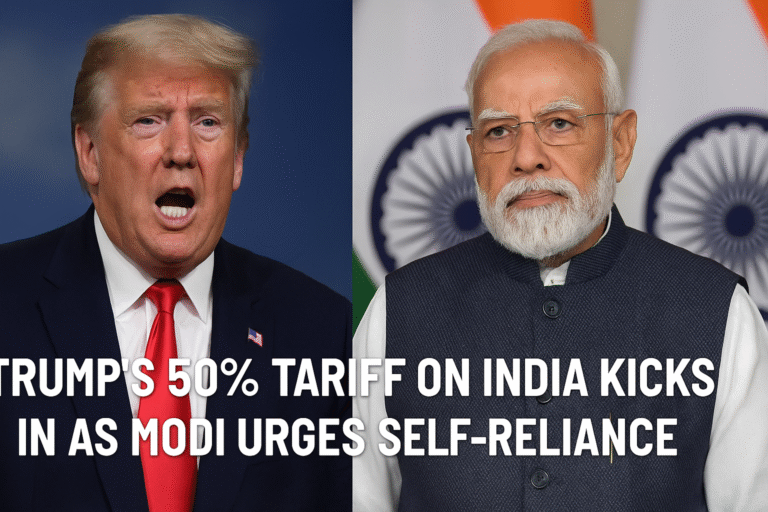Table of Contents
Introduction
In a dramatic escalation of global trade tensions, U.S. President Donald Trump has slapped a 50% tariff on Indian imports, a move that threatens to disrupt billions of dollars in trade between the two nations. The tariffs, effective August 27, 2025, have been justified by Washington as a response to India’s continued purchases of discounted Russian oil, a policy seen by the U.S. as undermining Western sanctions on Moscow.
At the same time, Prime Minister Narendra Modi has responded with a strong call for self-reliance (Atmanirbhar Bharat) and introduced a series of domestic tax reforms to protect India’s economy from external shocks.
What the Tariffs Cover
The 50% tariff is among the highest levies ever imposed on Indian goods by the U.S.. According to trade analysts:
- Around 66% of India’s $87 billion exports to the U.S. are affected.
- Products hardest hit include:
- Apparel & textiles
- Gems & jewelry (especially diamonds)
- Seafood & shrimp exports
- Carpets and handicrafts
- Furniture, leather, chemicals, and footwear
Meanwhile, strategic sectors like pharmaceuticals, semiconductors, steel, and automobiles remain exempt or face reduced tariffs (about 25%).
Economic Impact on India
The tariffs could deliver a severe blow to India’s economy:
- Exports to the U.S. could fall by 40–45%, according to the Global Trade Research Initiative (GTRI).
- The textile industry alone risks losing over 300,000 jobs.
- Diamond hubs like Surat anticipate significant layoffs due to reduced jewelry demand.
- Analysts at ICRIER warn that small and medium exporters will be hit hardest, as they lack diversified global markets.
This comes at a time when India is already managing global slowdown pressures, making the tariff shock even more significant.
Why Trump Imposed the Tariffs
The U.S. move is widely seen as a strategic pressure tactic linked to India’s continued purchase of Russian crude oil. Trump has argued that buying Russian oil indirectly funds Moscow’s war machine, undermining U.S. and European sanctions.
This has created a diplomatic rift, as India insists it will act in its own national interest and ensure affordable energy for its citizens.
Modi’s Response: Atmanirbhar Bharat & Tax Reforms
Prime Minister Narendra Modi has strongly condemned the tariffs as “unfair and unjustified” while doubling down on his Atmanirbhar Bharat (Self-Reliant India) vision.
Key measures announced include:
- Tax Reforms
- Simplified GST system to reduce compliance burden.
- Income tax cuts aimed at boosting household consumption.
- Export Diversification
- India is now expanding trade with 40+ countries, including the UK, Japan, Germany, South Korea, Australia, UAE, and Canada.
- Boosting Domestic Industry
- Stronger push for “Make in India, Make for the World.”
- Subsidies and incentives for sectors like textiles, electronics, and renewable energy.
- Strategic Alliances
- Strengthening ties with BRICS nations, including Russia and China.
- Modi is scheduled to attend the Shanghai Cooperation Organisation (SCO) summit in China, signaling a pivot toward Asian trade alliances.
Global Trade Reactions
- Investors Nervous: Global research firms like the Macro Research Board have downgraded Indian equities from “overweight” to “neutral.”
- Industry Alarm: Indian exporters fear a collapse of U.S. orders, while U.S. retailers warn of higher prices for American consumers.
- Geopolitical Risks: Experts warn this could push India closer to Russia and China, weakening U.S. influence in Asia.
Can India Withstand the Tariff Shock?
Despite the immediate setbacks, India still has strong fundamentals:
- A $3.9 trillion economy with one of the world’s largest domestic consumer markets.
- A booming services sector, including IT exports, which remain unaffected.
- Ongoing reforms in manufacturing and infrastructure that may reduce dependency on any single export market.
Modi’s call for self-reliance and diversification could turn this crisis into an opportunity by reshaping India’s long-term trade strategy.
Conclusion
The U.S.–India tariff war is more than an economic dispute—it reflects a shifting global order. While Trump’s 50% tariffs may cripple India’s export sectors in the short run, Modi’s Atmanirbhar Bharat push and market diversification efforts may strengthen India’s resilience in the long term.
The coming months will determine whether this conflict leads to a trade compromise or a deeper geopolitical realignment.

